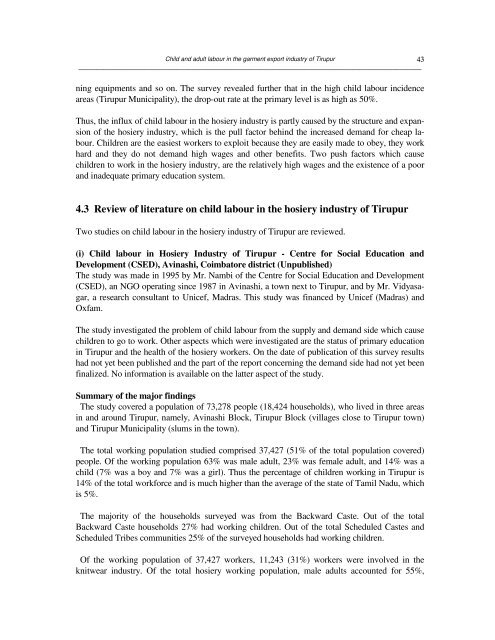Create successful ePaper yourself
Turn your PDF publications into a flip-book with our unique Google optimized e-Paper software.
<strong>Child</strong> <strong>and</strong> <strong>adult</strong> <strong>labour</strong> <strong>in</strong> <strong>the</strong> <strong>garment</strong> <strong>export</strong> <strong>in</strong>dustry <strong>of</strong> Tirupur<br />
──────────────────────────────────────────────────────────────────────────────────────────────<br />
n<strong>in</strong>g equipments <strong>and</strong> so on. The survey revealed fur<strong>the</strong>r that <strong>in</strong> <strong>the</strong> high child <strong>labour</strong> <strong>in</strong>cidence<br />
areas (Tirupur Municipality), <strong>the</strong> drop-out rate at <strong>the</strong> primary level is as high as 50%.<br />
Thus, <strong>the</strong> <strong>in</strong>flux <strong>of</strong> child <strong>labour</strong> <strong>in</strong> <strong>the</strong> hosiery <strong>in</strong>dustry is partly caused by <strong>the</strong> structure <strong>and</strong> expansion<br />
<strong>of</strong> <strong>the</strong> hosiery <strong>in</strong>dustry, which is <strong>the</strong> pull factor beh<strong>in</strong>d <strong>the</strong> <strong>in</strong>creased dem<strong>and</strong> for cheap <strong>labour</strong>.<br />
<strong>Child</strong>ren are <strong>the</strong> easiest workers to exploit because <strong>the</strong>y are easily made to obey, <strong>the</strong>y work<br />
hard <strong>and</strong> <strong>the</strong>y do not dem<strong>and</strong> high wages <strong>and</strong> o<strong>the</strong>r benefits. Two push factors which cause<br />
children to work <strong>in</strong> <strong>the</strong> hosiery <strong>in</strong>dustry, are <strong>the</strong> relatively high wages <strong>and</strong> <strong>the</strong> existence <strong>of</strong> a poor<br />
<strong>and</strong> <strong>in</strong>adequate primary education system.<br />
43<br />
4.3 Review <strong>of</strong> literature on child <strong>labour</strong> <strong>in</strong> <strong>the</strong> hosiery <strong>in</strong>dustry <strong>of</strong> Tirupur<br />
Two studies on child <strong>labour</strong> <strong>in</strong> <strong>the</strong> hosiery <strong>in</strong>dustry <strong>of</strong> Tirupur are reviewed.<br />
(i) <strong>Child</strong> <strong>labour</strong> <strong>in</strong> Hosiery Industry <strong>of</strong> Tirupur - Centre for Social Education <strong>and</strong><br />
Development (CSED), Av<strong>in</strong>ashi, Coimbatore district (Unpublished)<br />
The study was made <strong>in</strong> 1995 by Mr. Nambi <strong>of</strong> <strong>the</strong> Centre for Social Education <strong>and</strong> Development<br />
(CSED), an NGO operat<strong>in</strong>g s<strong>in</strong>ce 1987 <strong>in</strong> Av<strong>in</strong>ashi, a town next to Tirupur, <strong>and</strong> by Mr. Vidyasagar,<br />
a research consultant to Unicef, Madras. This study was f<strong>in</strong>anced by Unicef (Madras) <strong>and</strong><br />
Oxfam.<br />
The study <strong>in</strong>vestigated <strong>the</strong> problem <strong>of</strong> child <strong>labour</strong> from <strong>the</strong> supply <strong>and</strong> dem<strong>and</strong> side which cause<br />
children to go to work. O<strong>the</strong>r aspects which were <strong>in</strong>vestigated are <strong>the</strong> status <strong>of</strong> primary education<br />
<strong>in</strong> Tirupur <strong>and</strong> <strong>the</strong> health <strong>of</strong> <strong>the</strong> hosiery workers. On <strong>the</strong> date <strong>of</strong> publication <strong>of</strong> this survey results<br />
had not yet been published <strong>and</strong> <strong>the</strong> part <strong>of</strong> <strong>the</strong> report concern<strong>in</strong>g <strong>the</strong> dem<strong>and</strong> side had not yet been<br />
f<strong>in</strong>alized. No <strong>in</strong>formation is available on <strong>the</strong> latter aspect <strong>of</strong> <strong>the</strong> study.<br />
Summary <strong>of</strong> <strong>the</strong> major f<strong>in</strong>d<strong>in</strong>gs<br />
The study covered a population <strong>of</strong> 73,278 people (18,424 households), who lived <strong>in</strong> three areas<br />
<strong>in</strong> <strong>and</strong> around Tirupur, namely, Av<strong>in</strong>ashi Block, Tirupur Block (villages close to Tirupur town)<br />
<strong>and</strong> Tirupur Municipality (slums <strong>in</strong> <strong>the</strong> town).<br />
The total work<strong>in</strong>g population studied comprised 37,427 (51% <strong>of</strong> <strong>the</strong> total population covered)<br />
people. Of <strong>the</strong> work<strong>in</strong>g population 63% was male <strong>adult</strong>, 23% was female <strong>adult</strong>, <strong>and</strong> 14% was a<br />
child (7% was a boy <strong>and</strong> 7% was a girl). Thus <strong>the</strong> percentage <strong>of</strong> children work<strong>in</strong>g <strong>in</strong> Tirupur is<br />
14% <strong>of</strong> <strong>the</strong> total workforce <strong>and</strong> is much higher than <strong>the</strong> average <strong>of</strong> <strong>the</strong> state <strong>of</strong> Tamil Nadu, which<br />
is 5%.<br />
The majority <strong>of</strong> <strong>the</strong> households surveyed was from <strong>the</strong> Backward Caste. Out <strong>of</strong> <strong>the</strong> total<br />
Backward Caste households 27% had work<strong>in</strong>g children. Out <strong>of</strong> <strong>the</strong> total Scheduled Castes <strong>and</strong><br />
Scheduled Tribes communities 25% <strong>of</strong> <strong>the</strong> surveyed households had work<strong>in</strong>g children.<br />
Of <strong>the</strong> work<strong>in</strong>g population <strong>of</strong> 37,427 workers, 11,243 (31%) workers were <strong>in</strong>volved <strong>in</strong> <strong>the</strong><br />
knitwear <strong>in</strong>dustry. Of <strong>the</strong> total hosiery work<strong>in</strong>g population, male <strong>adult</strong>s accounted for 55%,


















